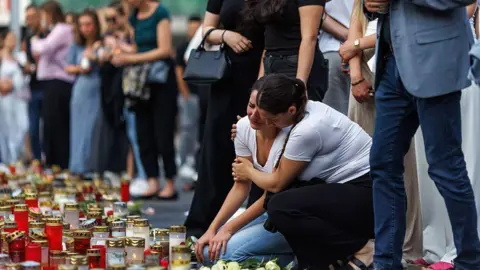The recent tragic incidents in Austria and France, occurring just hours apart, have left both nations in a state of shock and introspection regarding school violence and youth safety. In the early morning of Tuesday, a 14-year-old boy in Nogent, eastern France, fatally stabbed a school assistant during a routine bag check. Subsequently, in Graz, Austria, a 21-year-old ex-student, identified as Arthur A, launched a horrifying assault at Dreierschützengasse high school, using a Glock 19 handgun and a sawn-off shotgun, resulting in the deaths of nine students and a teacher before taking his own life. These simultaneous attacks have ignited a wave of concern and debate surrounding the effectiveness of safety measures in schools and the socio-cultural factors contributing to such violent behaviors.
The incident in Graz marks Austria’s most significant school shooting to date, raising serious questions about the country’s gun laws and mental health protocols. Arthur A was known to be introverted and had a deep fascination with violent video games. Reports indicate that he had also legally obtained the firearms used in the shooting after passing psychological evaluations and had received weapons training earlier that year. This information has catalyzed discussions on the need for stricter controls over gun ownership and the support systems for young individuals who struggle with mental health challenges. It was noted that Arthur A had failed military enlistment due to concerns over his psychological fitness, yet the legal framework prevented the military from sharing this critical information with other institutions, an issue that is now being scrutinized for potential reform.
In France, the fatal stabbing incident involved a teenager, Quentin, who reportedly acted out of a grudge against school staff after a reprimand days earlier. The initial investigation revealed that he came from a typical family environment with no previous signs of behavioral problems. Yet, his fascination with violent video games and his detached demeanor has prompted authorities to examine the potential influences of these media on youth behavior. Researchers and mental health professionals emphasize the importance of addressing underlying psychological issues and fostering a sense of community among adolescents who may feel isolated.
The contrast between these two incidents highlights the differing societal responses to youth violence in Austria and France. In Austria, President Alexander Van der Bellen has contemplated revising the country’s gun laws, while discussions have surfaced regarding the responsibility of adults to reintegrate marginalized youth back into society. Meanwhile, in France, politicians have called for stricter regulations around access to social media for minors and increased security measures in schools, although there is substantial debate over the efficacy of such measures. The government is also considering banning the sale of knives to minors, yet it was noted that the weapon used in the Nogent case was taken from the boy’s own home rather than purchased.
The situation underscores a broader dialogue on the role of social integration, mental health resources, and the influence of media on young people’s behavior. Analysts stress the need for increased investment in schools for the hiring of counselors and mental health professionals to identify students at risk before they resort to violence. However, the financial constraints facing these programs present significant challenges for both nations.
Collectively, these tragic events serve as a stark reminder of the urgent need for societies to prioritize the mental well-being of youth and to engage proactively in preventative measures. This dual tragedy has illuminated the complexities of addressing violence in schools, highlighting that it requires not just legislative action but a cultural shift in how communities support and engage their young members. Only through concerted efforts can both Austria and France hope to prevent such occurrences in the future and ensure the safety of their school environments.



